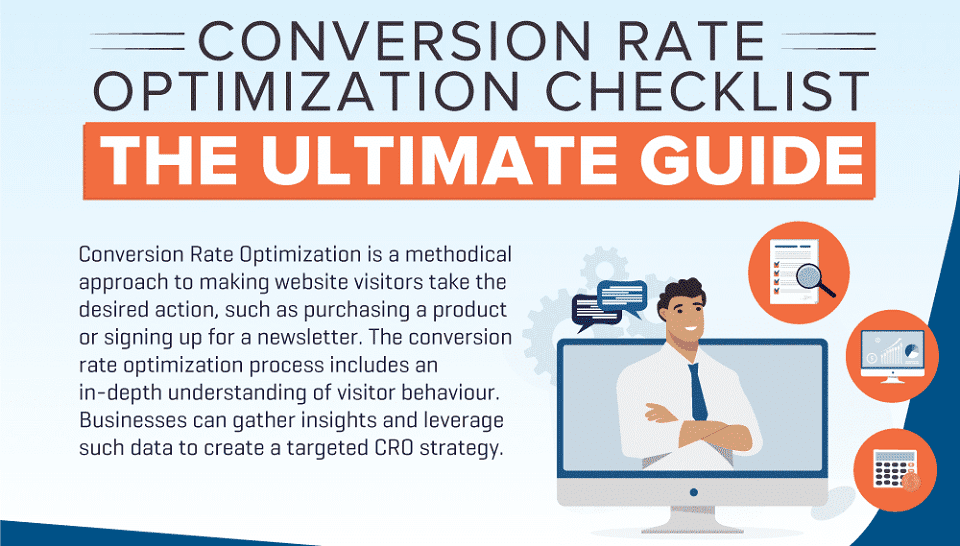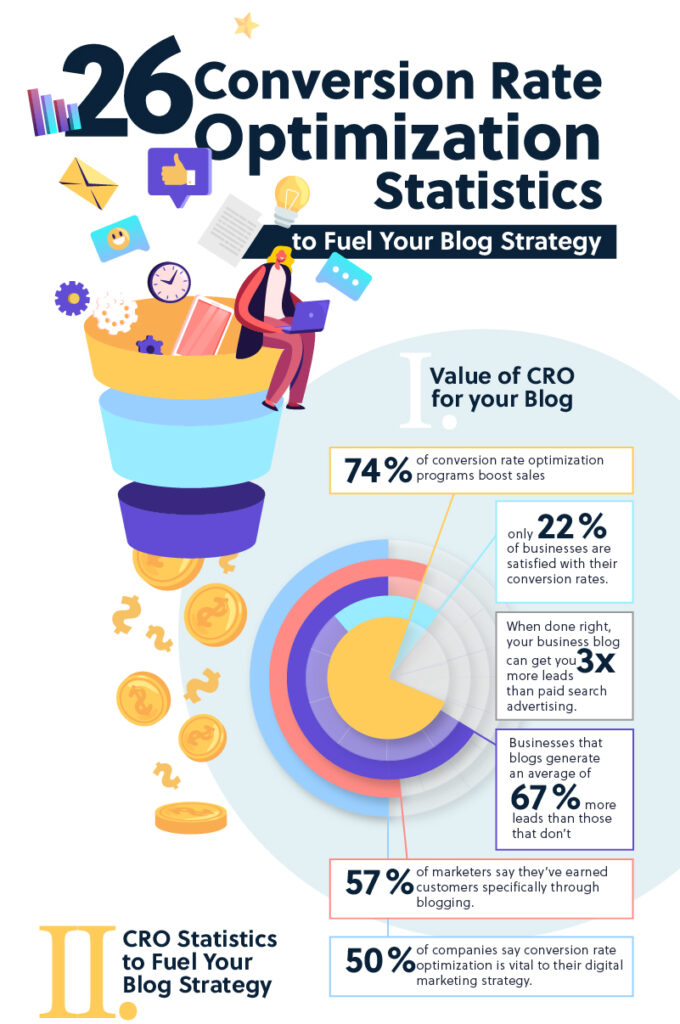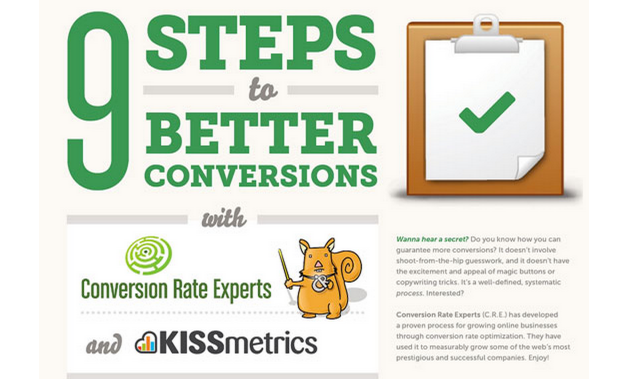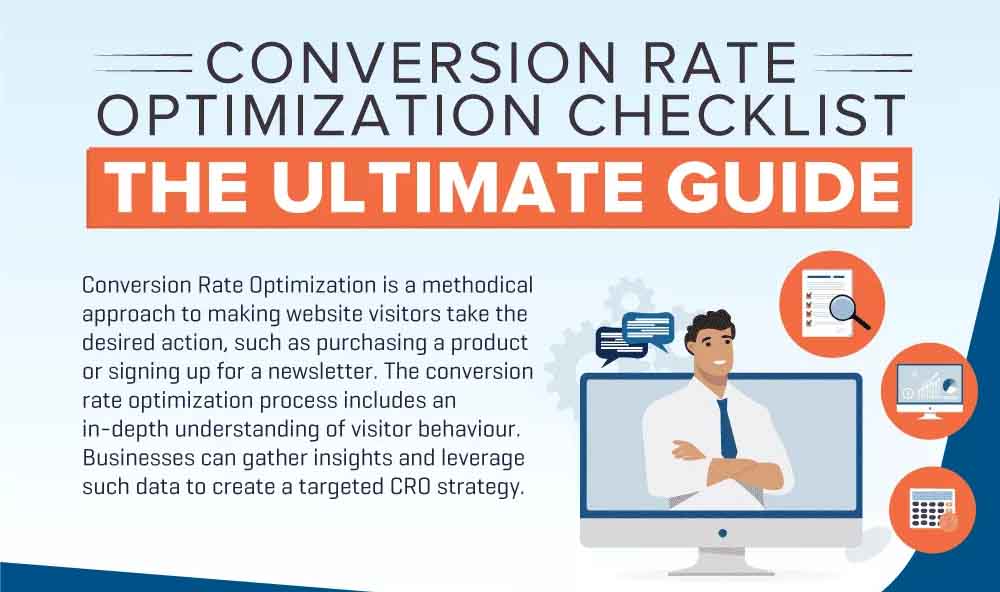Unlock the secrets to skyrocketing conversions with this in-depth guide to mastering Conversion Rate Optimization techniques. Must-read content!

Image courtesy of via DALL-E 3
Table of Contents
- Introduction to Conversion Rate Optimization (CRO)
- Understanding Conversion Rates
- Steps to Improve Conversion Rates
- Testing and Analyzing Your Website
- Optimizing Landing Pages
- Improving Website Content
- Monitoring and Adapting Strategies
- Common Mistakes to Avoid
- Summary and Conclusion
- Frequently Asked Questions (FAQs)
Introduction to Conversion Rate Optimization (CRO)
Welcome to the world of Conversion Rate Optimization (CRO), where websites strive to turn their visitors into valuable customers. In simple terms, CRO is the process of making your website more effective at getting people to take action, whether that’s making a purchase, signing up for a newsletter, or any other desired outcome.
What is Conversion Rate Optimization?
Conversion Rate Optimization, or CRO for short, is like giving your website a makeover to make it more appealing and user-friendly. By understanding what your website visitors are looking for and making it easier for them to find it, you increase the chances of them converting into customers.
Why Does CRO Matter?
Imagine having a store where hundreds of people walk in every day, but hardly anyone buys anything. That’s where CRO comes in. By improving your website’s conversion rate, you can make the most of the traffic you already have and grow your business without having to attract more visitors.
Understanding Conversion Rates
When we talk about conversion rates, we are looking at a very important metric that can help website owners understand how well their site is performing. Let’s break down what conversion rates are and how they are calculated.
What is a Conversion Rate?
A conversion rate is the percentage of visitors to a website who take a desired action, such as making a purchase, signing up for a newsletter, or filling out a contact form. For example, if a website has 100 visitors and 10 of them make a purchase, the conversion rate would be 10%.
How to Calculate Conversion Rates?
Calculating a conversion rate is a simple process. You divide the number of conversions by the total number of visitors and multiply by 100 to get a percentage. For instance, if a website had 500 visitors and 50 of them made a purchase, the conversion rate would be (50 / 500) x 100 = 10%.
Steps to Improve Conversion Rates
When you want to boost your website’s performance and turn visitors into customers, improving your conversion rates is key. Here are some practical steps to help you achieve just that:

Image courtesy of returnonnow.com via Google Images
Understand Your Audience
Knowing who your visitors are and what they are looking for is crucial. By understanding your audience, you can tailor your website to meet their needs and preferences effectively.
Make Your Website User-Friendly
An easy-to-use website is essential for keeping visitors engaged. Make sure your website is intuitive to navigate, loads quickly, and provides a smooth user experience across all devices.
Clear and Compelling Calls to Action (CTAs)
Your calls to action (CTAs) should be visible, concise, and persuasive. Use compelling language that prompts visitors to take action, whether it’s making a purchase, signing up for a newsletter, or contacting you.
Testing and Analyzing Your Website
A/B testing is a method used to compare two versions of a webpage to see which one performs better. This helps website owners understand what elements on their site lead to more conversions. For example, you can test two different headlines or button colors to see which one encourages visitors to click more. By analyzing the results of A/B testing, you can make informed decisions on how to optimize your website for higher conversion rates.
Using Analytics Tools
Analytics tools like Google Analytics provide valuable insights into how visitors interact with your website. They can show you important metrics such as how many people visit your site, where they come from, and which pages they spend the most time on. By utilizing these tools, you can track the performance of your website over time and identify areas that need improvement. This data-driven approach allows you to make strategic changes that enhance user experience and increase conversions.
Optimizing Landing Pages
Landing pages play a critical role in the success of a website by attracting and engaging visitors. Optimizing landing pages is essential to convert these visitors into customers. Let’s dive into what landing pages are and how you can make them more effective.

Image courtesy of www.contentremarketing.com via Google Images
What is a Landing Page?
A landing page is a standalone web page created specifically for a marketing or advertising campaign. It is where a visitor ‘lands’ after clicking on a link in an email, social media post, advertisement, or search engine result. Landing pages are designed to prompt a particular action, such as signing up for a newsletter, downloading a guide, or making a purchase.
Tips for Optimizing Landing Pages
1. Clear and Concise Messaging: Ensure that your landing page communicates your offer clearly and concisely. Use attention-grabbing headlines and relevant, persuasive content.
2. Compelling Call to Action (CTA): Your CTA should stand out on the page and clearly instruct visitors on what action to take next. Use actionable language that prompts immediate engagement, such as ‘Sign Up Now’ or ‘Get Started’.
3. Mobile Optimization: With the rise of mobile browsing, it is crucial to optimize your landing pages for mobile users. Ensure that your pages are responsive and load quickly on mobile devices.
4. A/B Testing: Experiment with different elements on your landing page, such as headlines, images, colors, and CTAs, to see which combinations drive the highest conversions. A/B testing can help you identify the most effective strategies for your audience.
5. Visuals and Multimedia: Use engaging visuals, such as images, videos, and infographics, to enhance the visual appeal of your landing page. Multimedia content can help convey your message more effectively and capture visitors’ attention.
By implementing these tips for optimizing landing pages, you can improve visitor engagement and increase conversion rates on your website.
Improving Website Content
One of the key elements in improving your website’s conversion rate is creating engaging content. This means making sure that the words on your website capture the visitor’s interest and keep them reading. To do this, think about what your audience wants to see and tailor your content to meet their needs. Use simple language and short sentences to make it easy for everyone to understand.
Using Visuals and Interactivity
Adding visuals like images and videos to your website can make a big difference in engaging your visitors. Pictures and videos can help to break up the text and keep people interested. Interactive elements, such as quizzes or games, can also make your website more fun and engaging. Remember, a picture is worth a thousand words, so don’t underestimate the power of visuals in capturing your audience’s attention.
Monitoring and Adapting Strategies
In the world of Conversion Rate Optimization (CRO), it’s not just about making changes once and forgetting about them. It’s crucial to continuously monitor your strategies and be ready to adapt to new trends in order to achieve the best results. Let’s delve into how you can effectively monitor and adapt your CRO strategies for continuous improvement.

Image courtesy of www.usertesting.com via Google Images
Tracking Your Progress
Tracking the progress of your CRO efforts is essential to understand what’s working and what’s not. By using tools like Google Analytics, you can gather valuable data on visitor behavior, conversion rates, and engagement metrics. Analyzing this data will help you identify patterns and areas for improvement, allowing you to make informed decisions on how to optimize your website further.
Adapting to New Trends
As the digital landscape is constantly evolving, it’s important to stay updated on new CRO trends and technology. What worked yesterday may not work tomorrow, so being flexible and willing to adapt is key to staying ahead of the competition. By keeping a close eye on industry news, attending webinars, and networking with other professionals, you can ensure that your CRO strategies remain effective and relevant in today’s fast-paced online environment.
Common Mistakes to Avoid
One of the common mistakes people make in Conversion Rate Optimization (CRO) is ignoring the importance of optimizing for mobile users. With the increasing use of smartphones and tablets, a significant portion of website traffic comes from mobile devices. Failing to cater to this audience can result in a poor user experience and lost conversions.
Overloading with Information
Another pitfall to avoid in CRO is overloading your website visitors with too much information. When a website bombards visitors with excessive text, images, and options, it can overwhelm and confuse them, leading to decision paralysis or a high bounce rate. To prevent this, keep your content clear, concise, and focused on guiding visitors towards a specific action.
Summary and Conclusion
In this comprehensive guide to Conversion Rate Optimization (CRO), we have learned about the importance of optimizing your website to convert more visitors into customers. By implementing specific strategies, you can increase your website’s performance and ultimately grow your business.

Image courtesy of www.searchrank.com via Google Images
Recap of Key Points
We began by understanding what CRO means and why it matters. Conversion Rate Optimization is essential for any website owner looking to improve conversions and drive business growth. By calculating conversion rates and taking steps to enhance user experience, you can see significant improvements in your website’s performance.
We explored various techniques to improve conversion rates, such as understanding your audience, creating user-friendly websites, and incorporating clear calls to action. Testing and analyzing your website using methods like A/B testing and analytics tools can provide valuable insights into what works best for your target audience.
Optimizing landing pages and improving website content were also highlighted as crucial aspects of CRO. By creating engaging content and using visuals and interactivity, you can increase visitor engagement and encourage more conversions.
Monitoring and adapting your strategies regularly is key to continuous improvement. Tracking your progress and adapting to new trends in CRO can help you stay ahead of the competition and maintain a high conversion rate.
Final Thoughts
Conversion Rate Optimization is a powerful tool that can help your business succeed online. By following the steps outlined in this guide and avoiding common mistakes, you can optimize your website for better conversions and overall success. Remember, persistence and a focus on user experience are key to seeing results from your CRO efforts.
Want to turn these SEO insights into real results? Seorocket is an all-in-one AI SEO solution that uses the power of AI to analyze your competition and craft high-ranking content.
Seorocket offers a suite of powerful tools, including a Keyword Researcher to find the most profitable keywords, an AI Writer to generate unique and Google-friendly content, and an Automatic Publisher to schedule and publish your content directly to your website. Plus, you’ll get real-time performance tracking so you can see exactly what’s working and make adjustments as needed.
Stop just reading about SEO – take action with Seorocket and skyrocket your search rankings today. Sign up for a free trial and see the difference Seorocket can make for your website!
Frequently Asked Questions (FAQs)
What is the best way to start with CRO?
Starting with Conversion Rate Optimization (CRO) can seem overwhelming, but the best way to begin is by understanding your audience. Take the time to analyze who your visitors are, what they are looking for, and what actions they are taking on your website. This will help you tailor your CRO strategy to meet their needs and preferences, ultimately leading to improved conversions.
How long does it take to see results from CRO?
The time it takes to see results from CRO can vary depending on various factors such as the current state of your website, the changes you implement, and your industry. In general, it’s essential to be patient and persistent with your CRO efforts. While some changes may show immediate results, others may take time to reflect in your conversion rates. Consistent monitoring, testing, and tweaking of your strategies will eventually lead to noticeable improvements in your conversion rates.
Do I need special tools for CRO?
While there are various tools available to aid in Conversion Rate Optimization, you don’t necessarily need special tools to get started. Simple tools like Google Analytics can provide valuable insights into your website’s performance and visitor behavior. Additionally, there are free CRO tools and resources online that can help you analyze your site and make informed decisions to improve your conversion rates. As you progress in your CRO journey, you may choose to invest in more advanced tools that suit your specific needs and goals.







